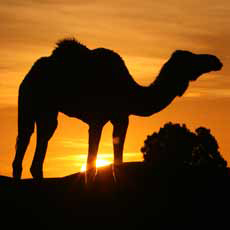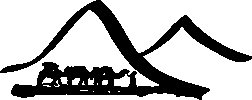

Brahim & Karla Ahansal
00212 (0)671161762 (BA) ![]()
00212 (0)617010702 (BA)
00212 (0)612668140 (KA)
0049 (0)1726021003 (KA) ![]()
info (at) desert-trekking.eu
GPS: 29.8268 -5.6663
Nützliche Informationen
Travel Luggage
Packing List for a Longer Stay in the Desert
This page offers a personal recommendation. Naturally, every participant is responsible for their own health and clothing preparation before the journey. The following suggestions are based on a 10-day trekking tour and can, of course, be adjusted to individual needs. As we do not wish to overload our animals — and since you may wish to ride from time to time — your luggage should not exceed 15 kg. For shorter trips into the desert, much less equipment is needed.
Luggage
Please use a soft backpack, duffel bag, or travel sack. Suitcases are too bulky for the animals. For daily use (water, camera, etc.), bring a small daypack, as we cannot stop the caravan every time someone needs a sip of water.
Sleeping Bag
Choose one suitable for temperatures between -5°C and +10°C (400–800 g down or 600–1200 g synthetic filling). Depending on the season, night temperatures can drop below zero.
Sleeping Mat
We provide simple foam mats. If you have back problems, we can bring an extra mat — this has proven to be very helpful.
Clothing
- 1 waterproof jacket or windbreaker
- 1 hat or scarf (you can also get a traditional Moroccan “cheche” from us)
- 1 down or fleece jacket and gloves (recommended from November to February)
- Several long-sleeved shirts or t-shirts for sun protection
- 1 warm pullover for cool evenings
- 2 light long trousers (keep one clean for travel days)
- Comfortable walking shoes (already worn in) or trekking sandals
- 1 pair of light sandals or trainers
- 2–3 pairs of socks (preferably cotton-blend to keep sand out)
- Enough underwear
- Swimwear (in case an opportunity arises – a well, spring, or rare water source)
- 1 set of nightwear or pyjamas
Equipment
- Small pillow (your daytime clothes can serve the same purpose)
- Towel
- Good sunglasses (many guests find they don’t need them – depends on eye sensitivity)
- Sunscreen, SPF 60 or higher
- Lip balm (optional)
- Penknife (do not carry in airplane hand luggage)
- Flashlight or headlamp
- Thermos or water bottle
- Several zip-lock freezer bags to protect valuables from sand
- Lighter
Toiletries
- Paper sandwich bags for collecting small waste
- Tissues or cotton handkerchiefs (the dry air can irritate the nose, especially in cold months)
- Moist wipes (toilet paper is provided; many guests appreciate having wipes as well)
- Soap, washcloth, toothbrush and toothpaste, and other personal items
First Aid Kit
- Sports or muscle gel
- Aspirin or mild pain reliever
- Eye drops
- Light anti-diarrheal (e.g. Imodium, Basika, Jatrox 600)
- Electrolyte drinks such as Elotrans
- Mineral tablets to replace salts lost through perspiration
- Blister plasters
- Antiseptic ointment for minor wounds or chafing
Vaccinations
This is a personal topic — it’s important not to over-vaccinate. There are no mandatory vaccinations for Morocco. Tetanus protection is standard. Hepatitis A/B vaccinations are often recommended by doctors in Europe, but not strictly necessary.
Photography Equipment
- If you use a camera with interchangeable lenses, bring a filter — it’s better to scratch the filter than the lens.
- Compact cameras are more delicate; keep them in a zip-lock bag when not in use.
- Enough film or memory cards
- Plastic bags with zip closure for storage and sand protection
A Kind Gesture
If you bring clothing that you no longer need after your journey, you are welcome to leave it with us. We distribute donated clothes and useful items such as torches, knives, and blankets to nomadic families in need. Please ensure the clothing is respectful of local customs. If you wish to help but are unsure what is most useful, simply get in touch with us — we will be happy to guide you.
Safety in Morocco
Safety in Morocco – A Personal Perspective
Here I, Karla Ahansal, would like to share only my personal view regarding safety in Morocco. I live here in the south of the country, at the edge of the Sahara, together with my family – and I can truly say that I feel very safe.
Compared to its neighboring countries, Morocco enjoys certain advantages in terms of political stability. As a monarchy, the state can react more swiftly and directly than a democracy might be able to in Europe.
In times of absolute peace (if such times even exist), the strong presence of security forces here might perhaps feel excessive. Yet in less certain times, I find it reassuring. Absolute safety never exists anywhere in the world, of course. But since tourism is one of Morocco’s most important economic sectors, the government responds quickly and effectively to any potential security issues. Experience from recent years shows how seriously and efficiently Morocco works to ensure safety within the country.
The general crime rate is lower than in countries such as Italy or Spain. People are, on the whole, polite, helpful, and honest. Of course, there are exceptions – especially in large cities – so it is always wise to keep an eye on your belongings.
In the south, it is still somewhat uncommon for Moroccan women to walk alone in public. Out of respect for local customs, foreign women might also wish to avoid this, as it could easily be misunderstood.
A Little Desert Guide
Here you will find a few guidelines for behavior that may differ from those in Europe.
Under construction
